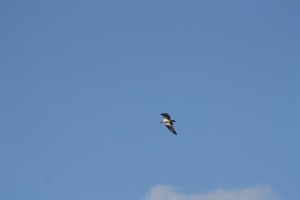Now that spring is showing us some signs that it just might stay awhile, have you ever wondered how birds know – sometimes before we do – that the weather is warming up and it’s okay to hang around? My writer, scrapbooking, and nature loving friend Shiela Fuller is back with a very interesting post about Ospreys that sheds some light on that question.
Each year since May 2012, wildlife biologists have been studying the migratory track of two adult ospreys from the Jamaica Bay Wildlife Refuge in Queens, New York to their wintering site in South America. Queens is the easternmost of five New York City boroughs and the second most populated. The main goal of the project was to gain public awareness of the refuge and cultivate interest in the inhabitants that live there.
The first osprey outfitted with a transmitter was Coley. During the summer of 2012 his movements were monitored 12 hours a day. He began his winter migration and headed south on September 10th, 2012. Seventeen days and 2600 miles later, Coley arrived at his winter home, Columbia, South America.
On May 5, 2013, Coley began his round trip back to Queens, NY and he arrived in 15 days and 7 hours.
Later in the month, Coley’s transmitter was removed and placed on another male osprey, Coley 2. Scientists would now track the movements of this bird. During the summer, Coley 2 spent a lot of time perched with his mate after nest failure. Staying close to the nest assured the pair that it would still be their home the following spring. 
Weather can affect migration and when Coley 2 left New York on September 2, 2013, he was headed into some pretty serious thunderstorms. He only traveled 44 miles and settled in Trenton, New Jersey for the first night of his trip. Coley 2 continued onward and made remarkable time considering his damp start. He arrived at his winter home, Lake Valencia in Venezuela, South America on September 17, 2013.
While at Lake Valencia, Coley 2 will spend his time fishing, eating, and resting until his internal signal tells him it is time to return to the nesting area.
What inspires birds to migrate north or south and how do they find their way? There are only scientific speculations but some say it is hormonal changes and/or the changes in the length of day/night hours that motivate migration. Navigation is a bit trickier to understand but some say birds rely on the position of the sun, those that travel at night rely on the North Star, and some scientists say that birds use landmarks to help them find their way just as humans do. That doesn’t explain a bird’s first migration. How would they know the landmarks if they never traveled before?
Scientists had been monitoring Coley 2 at Lake Valencia and were happy to note that he must know the weather is bad in the northeastern US and stayed a little longer at his warm winter home but on Sunday, March 16, 2014, just a few days ago, Coley 2 left and was traveling at a remarkable 250 miles per day. 
Scientists are not monitoring Coley 1, but he and his female partner were spotted on their platform nest in Jamaica Bay on March 23, 2014. Will Coley 2 be far behind? Will his female partner arrive before he does? Follow Coley 2 on his magnificent journey and you can even predict when he might arrive at his summer home: http://www.jamaicabayosprey.org.
For more details about the National Parks of New York Harbor Conservancy osprey project and to predict when Coley 2 will arrive go to: http://www.jamaicabayosprey.com http://www.nyharborparks.org
Footnotes: Another fabulous place to visit is the Cape May Bird Observatory. Their website for information is: http://www.njaudobon.org



Fascinating post, Darlene.